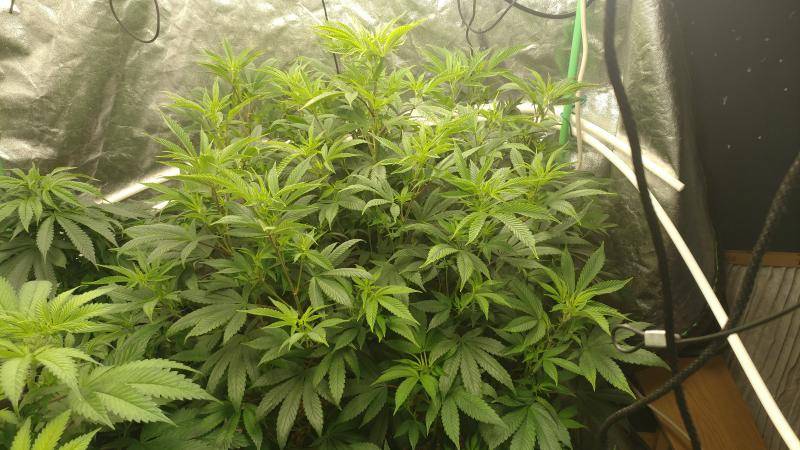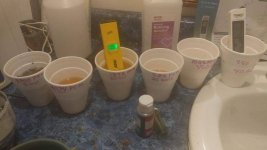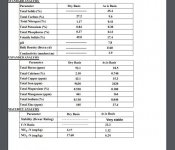-
Happy Birthday ICMag! Been 20 years since Gypsy Nirvana created the forum! We are celebrating with a 4/20 Giveaway and by launching a new Patreon tier called "420club". You can read more here.
-
Important notice: ICMag's T.O.U. has been updated. Please review it here. For your convenience, it is also available in the main forum menu, under 'Quick Links"!
You are using an out of date browser. It may not display this or other websites correctly.
You should upgrade or use an alternative browser.
You should upgrade or use an alternative browser.
The Lounge : Growers Round Table Discussion Thread
- Thread starter growingcrazy
- Start date
jackspratt61
Active member
Hey all I'm back I got my soil retested at spectrum. The number make way more sense than the last test.
what do you all think of my current soil
[URL=https://www.icmag.com/ic/picture.php?albumid=78785&pictureid=1926489&thumb=1]View Image[/url]
bases are off Frank...Ca = 38%
Mg = 36%
K = 11.5%
Na = 14.8%
Rinse the mix to reduce the Na...do you have an EC meter?
jackspratt61
Active member
Used the AA number for calcium and m3 for others. Got 17% Na, 38% Ca, 22% K, 21% Mg. That's... Something. How do your plants look?
bc...did you use 940 for Na? I don't see my error.
frankslan
Member
Plants look decent last couple rounds they keep yellowing out at week 3 and one run came out like hair it didnt want to finish right. Last run was good but like I said week 3 fade smaller buds too.
Im at week now only thing I see is a slight mag def and purple petioles Im just waiting for it to turn yellow on me though.

Im at week now only thing I see is a slight mag def and purple petioles Im just waiting for it to turn yellow on me though.
jackspratt61
Active member
Your plants are building on Na instead of K. Your #1 problem is available Ca,but with this level of Na I would start by rinsing the mix. You have high Al,Fe. Low P,Mn,Cu,Zn and B. Lots of undigested Ca.
Last edited:
jackspratt61
Active member
some gypsum can have high Na,kelp,crab meals,rock dusts and compost. I've tested some composts that are 11% Na...Calcium is the only way to remove Na. Is your mix wet?
jackspratt61
Active member
test
test
I too started with coot's mix...did you use the std. 1/3-1/3-1/3 (peat,compost,aeration)
test
Yes my soil is moist all the time. Its a coot mix standard no till mix. Im on my 6th run its about 2 years old problems began at cycle 5.
I too started with coot's mix...did you use the std. 1/3-1/3-1/3 (peat,compost,aeration)
frankslan
Member
Standard no till mix
1/3 compost 1/3 peat 1/3 pumice
1/2-3/4 cup kelp,Neem, and crab per foot
1 cup gypsum per foot
2 cups basalt rockdust
1 cup oyster shell
1/2 cup malted barley
Each cycle I topdress with ewc mix with 50 rice hulls. Ewc was made with blu blend compost and the standard amendments mixed in 1/2 cup kelp 1/2 neem 1/2 crab 1 cup oyster 2 cups rockdust. I actually removed the top couple inches of my soil this run
1/3 compost 1/3 peat 1/3 pumice
1/2-3/4 cup kelp,Neem, and crab per foot
1 cup gypsum per foot
2 cups basalt rockdust
1 cup oyster shell
1/2 cup malted barley
Each cycle I topdress with ewc mix with 50 rice hulls. Ewc was made with blu blend compost and the standard amendments mixed in 1/2 cup kelp 1/2 neem 1/2 crab 1 cup oyster 2 cups rockdust. I actually removed the top couple inches of my soil this run
jackspratt61
Active member
There are your sources leading to salt build-up. I lowered my compost portion to approx. 20% by cutting the existing mix after I washed it to around .6-.8EC. Choices are many but you must lower the Na and increase aeration while maintaining an evenly moisture retaining mix. For my mix that ended up being 35-40% peat,20% aeration(perlite/lava),10% vermiculite,10% bark and 20-25% compost. Rinse your peat well...it too can have excess Na. Maybe take 5gals of existing mix and rinse well then cut it until you like the 'feel' of it. Send that for testing. Keep notes of what you do including how much water you used to rinse the medium and the starting and final EC of the runoff. Learn the math...raise Ca to 80%...balance the metals...
bc...did you use 940 for Na? I don't see my error.
Just remarking on the sodium- however you cut it it's a lot like you said. Gotta get that Ca up and Mg/Na down
frankslan
Member
So you think its from my compost I was just looking at the numbers on sodium it say .1 percent so 1000ppm That would make sense idk where else it would come from.
I flush the 30 gal container with 40 gal of water. Got it down to around 900ppm from 3500ppm
I flush the 30 gal container with 40 gal of water. Got it down to around 900ppm from 3500ppm
Attachments
jackspratt61
Active member
So you think its from my compost I was just looking at the numbers on sodium it say .1 percent so 1000ppm That would make sense idk where else it would come from.
I flush the 30 gal container with 40 gal of water. Got it down to around 900ppm from 3500ppm
The Na build-up can come from several places...kelp,crab meal,compost,worm castings,poor quality gypsum,water source,rock dusts...
Send another sample in and see how the bases have moved.
frankslan
Member
The Na build-up can come from several places...kelp,crab meal,compost,worm castings,poor quality gypsum,water source,rock dusts...
Send another sample in and see how the bases have moved.
Thanks the compost def seems like it has high salts so I think its from there. I use ro water other amendments are top quality, gypsum is down to earth brand. My rockdust is basalt so I think that's straight.
I hope this flushing helped Im going to send another sample in a few weeks and see if the Na left. Then at the end of the round Im going to cut this mix and send that in for a test. Thank you for the help.
I bought this seagreen product for the flush. I guess it was orginally called desalinator plus or something. I legit think these type of product are bullshit but a couple of my plants were pissed off about being transplant for a week now and they all perked up after watering with this seagreen a couple hour after even the plant I flushed looked happier than ever.
Im researching it and the created said this,
"I have no problem responding to your question. No-till farming was intended to be something that was done outside where there were seasonal rains that washed away excess ions, namely sodium. The problem I've noticed with some indoor, or container garden, no-till farmers is that there is no runoff ever, while organic matter top dresses are continually applied. Even though the inputs are organic, many are marine based such as seabird guano or fish meal, or kelp meal, all of which may have rather high amounts of naturally occurring sodium. If the container is never watered to excess the sodium will never leave the system and will build up. The excess sodium displaces other beneficial cations, and even may cause chlorosis or necrosis. Also bacteria themselves are creating acids which are bringing into solution the required plant nutrients, but after a certain amount of runs these acids build up and create acidic soil conditions unless regular liming occurs.
When we mentioned that it can alleviate some of the harmful conditions that may arise out of no-till farming we are referring specifically to excess sodium. Sea Green contains halotrophic and chemotrophic bacteria which will immobilize sodium ions and buffer them from the rhizosphere. It's not a permanent fix but it will work pretty well for a long while.
Of course both of these issues can be alleviated through periodic flushing as if it were a winter rain. Though most indoor or container no-till farmers I have encountered do not incorporate such a practice into their regimen.
I hope this sheds light on to why that statement was made. We are big fans of Masanobu Fukuoka and respect no till farming very much."




